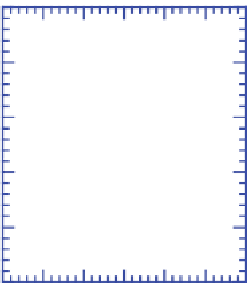Geoscience Reference
In-Depth Information
CF
2
Cl(g)
Cl(g)
CF
2
Cl
2
(g)
+
h
→
+
<
230 nm
50
CFC-12
Chlorofluoro-
Atomic
(11.22)
methyl radical
chlorine
HCFC-22
40
At 25 km,
e
-folding lifetimes of CFC-11 and -12 against
photolysis under maximum sunlight conditions are on
the order of 23 and 251 days, respectively. Average
lifetimes are on the order of two to three times these
values.
In sum, the limiting factor in CFC decomposition in
the stratosphere is not transport from the surface to the
tropopause or photochemical breakdown in the strato-
sphere, but transport from the tropopause to the middle
stratosphere. Table 11.2 indicates that the overall life-
times of CFC-11 and -12 between release at the surface
and destruction in the middle stratosphere are about 45
and 100 years, respectively. The lifetime of CFC-12
is longer than that of CFC-11, partly because the for-
mer compound must climb to a higher altitude in the
stratosphere before breaking apart than must the lat-
ter. Because of their long overall lifetimes, some CFCs
emitted since the 1930s are still present in the strato-
sphere. Those emitted today are likely to remain in the
air until the second half of the twenty-first century.
30
CFC-12
20
Tropopause
10
0
0
100
200
300
400
500
600
Mixing ratio (pptv)
Figure 11.13.
Variation of CFC-11 and -12, HCFC-22,
and CCl
4
(g) with altitude at 30
◦
N latitude. CFC,
chlorofluorocarbon; HCFC, hydrochlorofluorocarbon.
Smoothed and scaled from Jackman et al. (1996) to
2011 near-surface mixing ratios.
11.5.2. Lifetimes and Mixing Ratios
of Chlorinated Compounds
Once emitted, CFCs take about 1 year to mix up to the
tropopause. Because they are chemically unreactive and
cannot be broken down by solar wavelengths that reach
the troposphere, CFCs are not removed chemically from
the troposphere. Instead, they become well mixed in the
troposphere (Figure 11.13) and slowly penetrate to the
stratosphere. Today, the tropospheric mixing ratios of
CFC-11 and -12, the two most abundant CFCs, are about
240 and 530 pptv, respectively (Table 11.2).
11.5.2.2. Lifetimes of Nonchlorofluorocarbons
Overall lifetimes of non-CFC chlorinated compounds
are often shorter than are those of CFCs. The lifetimes
of CCl
4
(g), HCFC-22(g), CH
3
CCl
3
(g), CH
3
Cl(g), and
HCl(g) between emission and chemical destruction are
about 25 years, 12 years, 7 years, 1.3 years, and less than
0.1 year, respectively (Table 11.2). Non-CFCs generally
have shorter lifetimes than do CFCs because the former
react faster with OH(g) and are often more water solu-
ble than are the latter. The benefit of a shorter lifetime
for a chlorine-containing compound is that, if its break-
down occurs in the troposphere, the chlorine released
can be converted to HCl(g), which is highly soluble
and can be removed readily by its dissolution in rain-
water. Because the stratosphere does not contain clouds,
except ice-containing clouds that form seasonally over
the poles, HCl(g) cannot be rained out of the strato-
sphere. Some non-CFCs, such as HCFC-22, photolyze
slower than do CFCs, so once HCFC-22 reaches the
middle stratosphere, its concentration builds up there to
agreater extent than do concentrations of several CFCs,
as seen in Figure 11.13.
Of non-CFC chlorine compounds, CH
3
Cl(g) and
HCl(g) have the largest natural sources. The tropo-
spheric
e
-folding chemical lifetime of CH
3
Cl(g) against
reaction by OH(g) is about 1.5 years, whereas that of
11.5.2.1. Lifetimes of Chlorofluorocarbons
Because the stratosphere is one large temperature inver-
sion, vertical transport of ozone through it is slow.
About 10 megatonnes (Mt) of chlorine in the form of
CFCs reside in the troposphere, and the transfer rate of
CFC-chlorine from the troposphere to the middle strato-
sphere is about 0.1 Mt/yr. In this simplified scenario, the
average time required for the transfer of a CFC molecule
from the troposphere to the middle stratosphere is about
100 years.
CFCs are broken down in the stratosphere only when
they are exposed to far-UV radiation (wavelengths of
0.01-0.25
m), and this exposure occurs at an altitude
of 12 to 20 km and higher. At such altitudes, far-UV
wavelengths photolyze CFC-11 and -12 by
CFCl
2
(g)
Cl(g)
CFCl
3
(g)
+
h
→
+
<
250 nm
CFC-11
Dichlorofluoro-
Atomic
(11.21)
methyl radical
chlorine













Search WWH ::

Custom Search